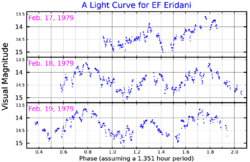Astronomy:EF Eridani
| Observation data Equinox J2000.0]] (ICRS) | |
|---|---|
| Constellation | Eridanus |
| Right ascension | 03h 14m 13.25262s[2] |
| Declination | −22° 35′ 42.9001″[2] |
| Apparent magnitude (V) | 14.5–17.3[3] |
| Characteristics | |
| Variable type | E+XM[3] |
| Astrometry | |
| Radial velocity (Rv) | 70[4] km/s |
| Proper motion (μ) | RA: 137.993[2] mas/yr Dec.: -55.971[2] mas/yr |
| Parallax (π) | 6.2327 ± 0.1417[2] mas |
| Distance | 520 ± 10 ly (160 ± 4 pc) |
| Other designations | |
| Database references | |
| SIMBAD | data |
EF Eridani (abbreviated EF Eri, sometimes incorrectly referred to as EF Eridanus) is a variable star of the type known as polars, AM Herculis stars, or magnetic cataclysmic variable stars. Historically it has varied between apparent magnitudes 14.5 and 17.3, although since 1995 it has generally remained at the lower limit. The star system consists of a white dwarf with a substellar-mass former star in orbit.
EF Eridani B
The substellar mass in orbit around the white dwarf is a star that lost all of its gas to the white dwarf. What remains is an object with a mass of 0.05 solar masses (M☉), or about 53 Jupiter masses (|♃|J}}}}}}), which is too small to continue fusion, and does not have the composition of a super-planet, brown dwarf, or white dwarf. There is no category for such a stellar remnant.[5]
It is theorized that 500 million years ago, the white dwarf started to cannibalize its partner, when they were separated by 7 million km. As it lost mass, the regular star spiraled inward. Today, they are separated by a mere 700,000 km for an orbital period of 81 min. The orbit is expected to continue to shrink due to gravitational radiation.[5]
See also
- AM Herculis
- Cataclysmic variable star
- Polar (cataclysmic variable)
- Variable stars
- Stellar remnants
- PSR J1719-1438 b, a planetary-mass former star that was eroded by its binary star partner, PSR J1719-1438
- PSR J1544+4937 b
- PSR B1957+20 b
References
- ↑ Williams, G.; Hiltner, W. A. (April 1980). "Light curve of the optical counterpart of 2A 0311-227". Publications of the Astronomical Society of the Pacific 92: 178–182. doi:10.1086/130643. Bibcode: 1980PASP...92..178W.
- ↑ 2.0 2.1 2.2 2.3 Vallenari, A. et al. (2022). "Gaia Data Release 3. Summary of the content and survey properties". Astronomy & Astrophysics. doi:10.1051/0004-6361/202243940 Gaia DR3 record for this source at VizieR.
- ↑ 3.0 3.1 3.2 "Query= EF Eri". General Catalogue of Variable Stars. Centre de Données astronomiques de Strasbourg. http://www.sai.msu.su/gcvs/cgi-bin/search.cgi?search=EF+Eri.
- ↑ "V* EF Eri – Nova-like Star". SIMBAD. Centre de Données astronomiques de Strasbourg. http://simbad.u-strasbg.fr/simbad/sim-id?Ident=EF+Eri.
- ↑ 5.0 5.1 Beuermann, K.; Wheatley, P.; Ramsay, G.; Euchner, F.; Gänsicke, B. T. (February 2000). "Evidence for a substellar secondary in the magnetic cataclysmic binary EF Eridani". Astronomy and Astrophysics Letters 354: L49–L52. Bibcode: 2000A&A...354L..49B.
External links
 |


